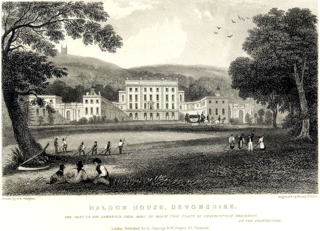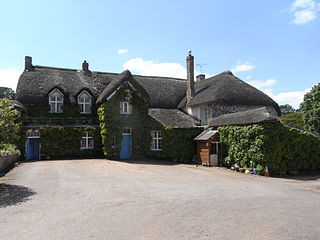
Prideaux Place is a grade I listed Elizabethan country house in the parish of Padstow, Cornwall, England. It has been the home of the Prideaux family for over 400 years. The house was built in 1592 by Sir Nicholas Prideaux (1550–1627), a distinguished lawyer, and was enlarged and modified by successive generations, most notably by his great-great-grandson Edmund Prideaux (1693–1745) and by the latter's grandson Rev. Charles Prideaux-Brune (1760–1833). The present building, containing 81 rooms, combines the traditional E-shape of Elizabethan architecture with the 18th-century exuberance of Horace Walpole’s Strawberry Hill Gothic.

Prideaux is both a given name and surname of Cornish origin, derived from the place called Prideaux in the parish of Luxulyan. The place-name had the form Pridias in the 12th and 13th centuries; by folk etymology both the place-name and the surname have been altered to a form based on the French près d'eaux or pré d'eaux.

Edmund Prideaux of Forde Abbey, Thorncombe, Devon, was an English lawyer and Member of Parliament, who supported the Parliamentary cause during the Civil War. He was briefly solicitor-general but chose to resign rather than participate in the regicide of King Charles I. Afterwards, he was attorney-general, a position he held until he died. During the Civil War and for most of the First Commonwealth he ran the postal service for Parliament.
Bowden is a historic estate in the parish of Yealmpton in Devon, England. From the 15th century until 1748 the manor house was for eight generations the seat of a junior branch of the Copleston family of Copplestone. The manor house was largely rebuilt in the 19th century and, together with some of its outbuildings, now serves as a farmhouse.

Sir Richard Edgcumbe of Cotehele in the parish of Calstock in Cornwall, was an English courtier and Member of Parliament.

Farway is a small village, civil parish and former manor in the East Devon district of Devon, England. The village is situated about 3+1⁄2 miles (5.6 km) south-east of Honiton. The village lies on the River Coly, which rises in the north of the civil parish and which is crossed by a ford in the village.

Sir John Chichester of Raleigh in the parish of Pilton, near Barnstaple in North Devon, was a leading member of the Devonshire gentry, a naval captain, and ardent Protestant who served as Sheriff of Devon in 1550-1551, and as Knight of the Shire for Devon in 1547, April 1554, and 1563, and as Member of Parliament for Barnstaple in 1559, over which borough his lordship of the manor of Raleigh, Pilton had considerable influence.

Nutwell in the parish of Woodbury on the south coast of Devon is a historic manor and the site of a Georgian neo-classical Grade II* listed mansion house known as Nutwell Court. The house is situated on the east bank of the estuary of the River Exe, on low-lying ground nearly contiguous to the water, and almost facing Powderham Castle similarly sited on the west bank. The manor was long held by the powerful Dynham family, which also held adjacent Lympstone, and was according to Risdon the site of their castle until John Dynham, 1st Baron Dynham (1433–1501), the last in the male line, converted it into "a fair and stately dwelling house".

Sir Edmund Prideaux, 1st Baronet (1554–1628), of Netherton in the parish of Farway, Devon, was a Councillor at Law and Double Reader of the Inner Temple and was created a baronet on 17 July 1622. He purchased the estate of Netherton where in 1607 he built a new mansion house, known today as Netherton Hall, a grade II listed building. He was one of John Prince's Worthies of Devon.

Sir Peter Prideaux, 3rd Baronet (1626–1705), of Netherton in the parish of Farway, near Honiton, Devon, was an English politician.

Haldon House on the eastern side of the Haldon Hills in the parishes of Dunchideock and Kenn, near Exeter in Devon, England, was a large Georgian country house largely demolished in the 1920s. The surviving north wing of the house, comprising the entrance front of the stable block, consists of two cuboid lodges linked by a screen pierced by a Triumphal Arch, with later additions, and serves today as the "Lord Haldon Hotel". The house was originally flanked by two such paired pavilions, as is evident from 19th century engravings.

John Peryam, of Exeter, Devon, was elected four times as a Member of Parliament, for Barnstaple 1584, Bossiney 1586, Exeter 1589 and 1593. He served as Mayor of Exeter. He was the younger brother of Sir William Peryam (1534-1604) of Little Fulford, near Crediton in Devon, Lord Chief Baron of the Exchequer.

Creedy is an historic estate in the parish of Sandford, near Crediton in Devon. It is named from its location on the west side of the River Creedy. It was the seat of the Davie family from about 1600 until the late 20th century. The mansion house on the estate has been called at various times New House, Creedy House, and as presently, Creedy Park. It was first built in about 1600, rebuilt in 1846, burnt down in 1915 and rebuilt 1916–21. It is surrounded by a large park, the boundary of which is enclosed by a stone and brick wall several miles long.

Soldon in the parish of Holsworthy Hamlets, Devon, England, is a historic estate, a seat of the Prideaux family. The manor house is a grade II listed building dating from the mid-16th century with later alterations. It was sold in 2014 as an eight bedroomed house with an acre and a half of grounds for an asking price of £750,000.

Spencer Combe in the parish of Crediton, Devon, is an historic estate. The grade II listed farmhouse known today as "Spence Combe", the remnant of a former mansion house, is situated 3 miles north-west of the town of Crediton.

Orcheton is an historic estate in the parish of Modbury in Devon. The present house, known as Great Orcheton Farm is situated 1+1⁄2 miles south-west of Modbury Church.

Sir Thomas Pridias lord of the manor of Newham in the parishes of Kenwyn and Kea, immediately south of the parish of Truro, in Cornwall, was a Member of Parliament for Cornwall in 1298.

Great House on South Street in the town of Colyton, Devon, is the remnant of an historic Elizabethan mansion house built by the Yonge family, originally prominent wool merchants in the town, later Yonge baronets. It is a grade II* listed building.
Sandridge is an historic estate in the parish of Stoke Gabriel in Devon, situated on high ground at the head of the River Dart estuary. The estate was originally encompassed on three sides by the river, which meanders along its border, leaving it on the east side. The present grade II* listed Italianate style Regency mansion house known as Sandridge House was built in 1805 by Lady Ashburton, to the design of John Nash.

Sir Edmund Prideaux, 4th Baronet (1647–1720), of Netherton, Farway was a British lawyer and politician who sat in the House of Commons from 1713 to 1720.



















